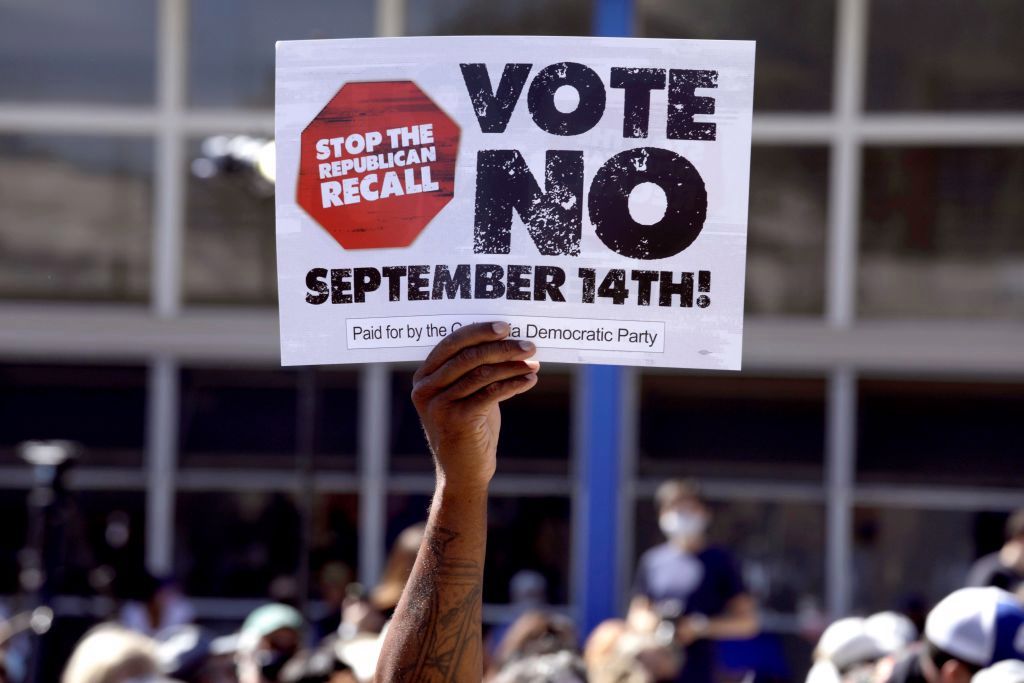
Source: Genaro Molina / Getty
Over a year before the 2022 general election, the California recall election is generating much attention. What started off as a long-shot frustration before the pandemic turned into a referendum on Gov. Gavin Newsom’s handling of various issues.
Los Angeles’ KTLA reported a possible saving grace for Newsom is that the state is less Republican and less white than 18 years ago. But whether Newsom will hold onto his seat depends on eligible voters turning out to vote.
Newsom’s recall is not impossible. Actor and former Gov. Arnold Schwarzenegger was elected during a recall election in 2003. Despite over 50 attempts to recall a governor, Schwarzenegger is the only person successfully elected during a recall election.
Election day is officially Tuesday, Sept. 14, with voters having the option to vote in person or return their mail-in ballot. All eligible California voters were sent a recall ballot. If mailed, ballots must be postmarked by Sept. 14 and received within a week to count. A voter can also return their ballot in person on Tuesday. For more information on methods for returning their ballot. voters can check the secretary of state’s website or their local county elections office.
Whether you’re a California voter trying to decide if it’s worth voting or a curious observer watching from out of state, there’s a lot to unpack. Here are some facts about the recall election:
What is a recall election?
A recall is a way for voters to remove an elected official from office. According to the National Conference of State Legislatures, only 19 states permit the recall of a state elected official. It’s estimated that 30-38 states have provisions to recall local officials.
The guidelines for a recall are state-dependent. But usually, it requires gathering citizen signatures on a recall petition and then a new election. Some states require a specific ground for recall to be met before an application to circulate a petition will be accepted.
How does a recall work in California?
The recall has been available to Californians since 1911. The secretary of state’s website describes the recall ballot as consisting of two parts. First is the question, “shall GAVIN NEWSOM be recalled (removed) from the office of Governor?”
The strategy for Newsom and the many Democrats supporting him is to encourage voters to vote “no” and then leave the second question on the ballot blank. If at least 50% of voters vote “no,” the recall is unsuccessful, and Newsom will remain in his seat until the 2022 election.
Good morning! It’s a great day to VOTE NO on the California recall! Pass it on. #VoteNoOnTheRecall pic.twitter.com/N7whbmTsSv
— MeidasTouch.com (@MeidasTouch) September 12, 2021
The second part lists the candidates who have qualified to replace Newsom if there is a successful recall. Newsom is not listed in the second part. So a voter wouldn’t be able to vote “no” and then select Newsom as a fallback. The point of the process is to replace him.
But why does California have a recall?
As Five Thirty-Eight recently explained, it is easier to initiate a recall election in California than other states. California has a long process. In California, an individual or group petitioning for the recall has seven and a half months to gather enough signatures. The secretary of state’s office verified over 1 million signatures.
Polling ahead of election day shows Californians reject the recall overall. But much of the focus has been on conservative radio host Larry Elder, who continues to lead the pack of 46 challengers.

Source: Francine Orr / Getty
Elder, a conservative radio show host, would ordinarily be considered a novelty in a field for such a high office. But the recall election changes the rules of who traditionally rises to the front of the pack.
Elder’s rise also raises questions about representation in politics and whether having a Black face in a high place improves conditions. If the recall is successful and Elder emerged victoriously, he would be the first Black governor of California. Elder has made comments about slavery and civil rights, which are antithetical to the experiences and needs of Black and other Americans of color.
Why should people outside of California care?
Beyond Elder’s candidacy, some think the recall election has potential implications for future elections. An op-ed published in The Atlanta Voice shared that having a large allegedly “blue” state like California oust a Democratic governor could signal the ability to advance opportunity for Black and other communities of color nationwide.
With an elderly senator who could be replaced before a new governor would take office in January 2023, losing ground in the Senate would cost Democrats the slim majority. Any chance at moving forward issues such as voting rights and abortion could go out the window.
The California recall is a dress rehearsal for how to mobilize GOP voters around attempts to overturn election results — with far more serious threats of success on the horizon in places where the party has more control: https://t.co/7RWn4YX6CC
— Taniel (@Taniel) September 10, 2021
For his part, Elder has taken a page out of the Trump handbook. He is reportedly consulting lawyers if he loses, claiming the process is “rigged” with pre-emptive allegations about virtually non-existent voter fraud.
Keeping the fallacy of widespread fraud going into the next election cycle only extends the battle against political disinformation that began in the 2020 presidential election. Reports indicate Elder has a form on his website asking voters to challenge a Newsom victory.
See Also:
[ione_media_gallery id=”3039818″ overlay=”true”]
window.addEventListener(‘interaction’, function () {
setTimeout(function () {
var s = document.createElement(‘script’), el = document.getElementsByTagName(‘script’)[ 0 ];
s.async = true;
s.src = ‘https://platform.twitter.com/widgets.js’;
el.parentNode.insertBefore(s, el);
}, 1000)
});
